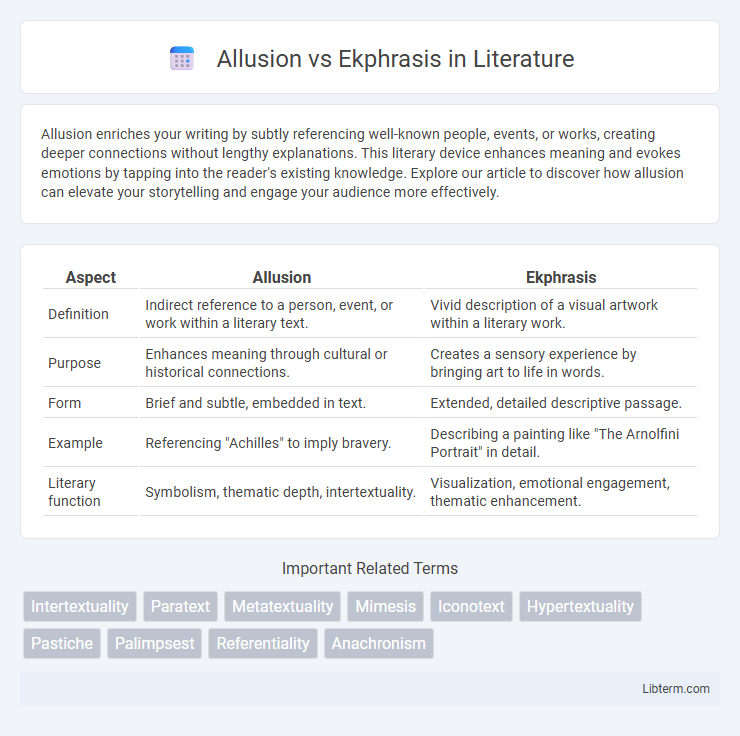Allusion enriches your writing by subtly referencing well-known people, events, or works, creating deeper connections without lengthy explanations. This literary device enhances meaning and evokes emotions by tapping into the reader's existing knowledge. Explore our article to discover how allusion can elevate your storytelling and engage your audience more effectively.
Table of Comparison
| Aspect | Allusion | Ekphrasis |
|---|---|---|
| Definition | Indirect reference to a person, event, or work within a literary text. | Vivid description of a visual artwork within a literary work. |
| Purpose | Enhances meaning through cultural or historical connections. | Creates a sensory experience by bringing art to life in words. |
| Form | Brief and subtle, embedded in text. | Extended, detailed descriptive passage. |
| Example | Referencing "Achilles" to imply bravery. | Describing a painting like "The Arnolfini Portrait" in detail. |
| Literary function | Symbolism, thematic depth, intertextuality. | Visualization, emotional engagement, thematic enhancement. |
Introduction to Literary Devices: Allusion and Ekphrasis
Allusion and ekphrasis are literary devices that enrich a text by creating deeper meaning through indirect reference and vivid description. Allusion subtly references a person, place, event, or work of art outside the text, relying on the reader's familiarity to evoke additional layers of understanding. Ekphrasis provides a detailed, often dramatic, description of a visual artwork within the literary work, transforming the visual into a verbal experience that enhances thematic resonance.
Defining Allusion: Meaning and Purpose
Allusion is a literary device that involves indirectly referencing a person, event, or work of art to enrich the text's meaning and evoke deeper understanding. Its purpose is to create connections and add layers of significance without explicit explanation, allowing readers to draw on their prior knowledge. Unlike ekphrasis, which vividly describes a visual artwork, allusion functions through subtle hints that engage the reader's interpretative skills.
Defining Ekphrasis: Meaning and Usage
Ekphrasis is a literary device where a vivid, detailed description of a visual artwork is embedded within a text, allowing readers to visualize and emotionally engage with the artwork through words. Unlike allusion, which indirectly references a work or concept, ekphrasis offers an immersive, explicit depiction meant to evoke sensory and imaginative responses. This technique is frequently used in poetry and prose to deepen thematic complexity and create a multi-layered experience between the visual and verbal arts.
Key Differences Between Allusion and Ekphrasis
Allusion refers to an indirect reference to a person, event, or work of art, often requiring the reader to infer meaning based on prior knowledge, while ekphrasis vividly describes a specific artwork to evoke sensory experience and emotional response. Allusions typically serve as literary shortcuts to enrich text through cultural or historical connections, whereas ekphrasis functions as a detailed narrative technique that brings visual art to life within a textual medium. The key difference lies in allusion's subtlety and reliance on external context compared to ekphrasis's explicit, immersive portrayal of a visual subject.
Historical Origins of Allusion
Allusion originates from classical literature, where writers subtly referenced myths, historical events, or earlier texts to enrich their narratives. Its historical roots lie in ancient Greek and Roman traditions, embedding cultural knowledge to create layered meanings for educated audiences. Unlike ekphrasis, which vividly describes visual art to evoke imagery, allusion relies on indirect literary or cultural hints to expand interpretative depth.
Historical Background of Ekphrasis
Ekphrasis originated in ancient Greek literature as a vivid, detailed description of a visual work of art, primarily seen in Homer's epics where scenes like the Shield of Achilles illustrated the technique. The term derives from the Greek word "ekphrasis," meaning "to speak out," reflecting its purpose to bring artwork to life through poetic language. Historically, ekphrasis evolved from mere description to a complex intermedial dialogue between text and visual representation in both classical and Renaissance art and literature.
Examples of Allusion in Literature
Allusion often appears in literature through references to well-known historical events, myths, or other literary works, such as the mention of Achilles in T.S. Eliot's "The Waste Land" or the biblical allusion to Eden in John Milton's "Paradise Lost." Unlike ekphrasis, which vividly describes visual art within a text, allusion relies on the reader's prior knowledge to evoke deeper meaning through indirect recognition. Shakespeare's frequent nods to classical mythology and the Bible exemplify how allusions enrich narrative layers and character development without explicit explanation.
Famous Ekphrasis Examples in Poetry and Prose
Famous ekphrasis examples in poetry include John Keats' "Ode on a Grecian Urn," which vividly describes the imagery on an ancient urn to explore themes of beauty and eternity. In prose, Oscar Wilde's "The Picture of Dorian Gray" exemplifies ekphrasis by centering the narrative around a portrait that reflects the protagonist's moral decay. These works demonstrate how ekphrasis transforms visual art into rich literary expression, differing from allusion by providing detailed, evocative descriptions rather than brief references.
The Impact of Allusion vs Ekphrasis on Reader Interpretation
Allusion subtly enriches reader interpretation by invoking prior knowledge, creating layers of meaning that engage memory and cultural context. Ekphrasis intensifies visualization through vivid, detailed descriptions of art within text, prompting immersive sensory experience and emotional resonance. Together, these techniques shape interpretive depth by blending intellectual recognition with sensory imagination, enhancing narrative complexity.
When to Use Allusion vs Ekphrasis in Creative Writing
Use allusion in creative writing to subtly evoke broader themes, historical contexts, or cultural references without elaboration, enriching the narrative through implied meaning. Employ ekphrasis when the goal is to provide a vivid, detailed description of a visual artwork or object, engaging readers' senses and creating a strong imagery connection within the text. Choose allusion for concise symbolic resonance and ekphrasis for immersive, descriptive storytelling.
Allusion Infographic

 libterm.com
libterm.com